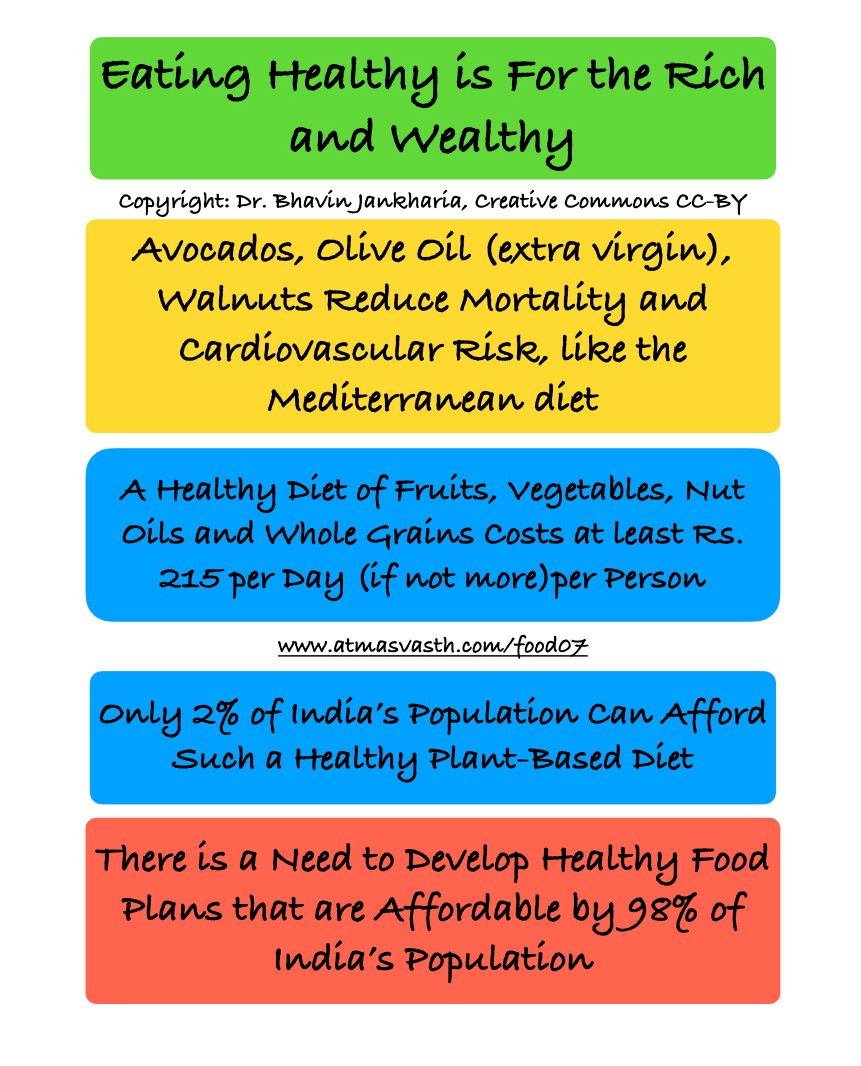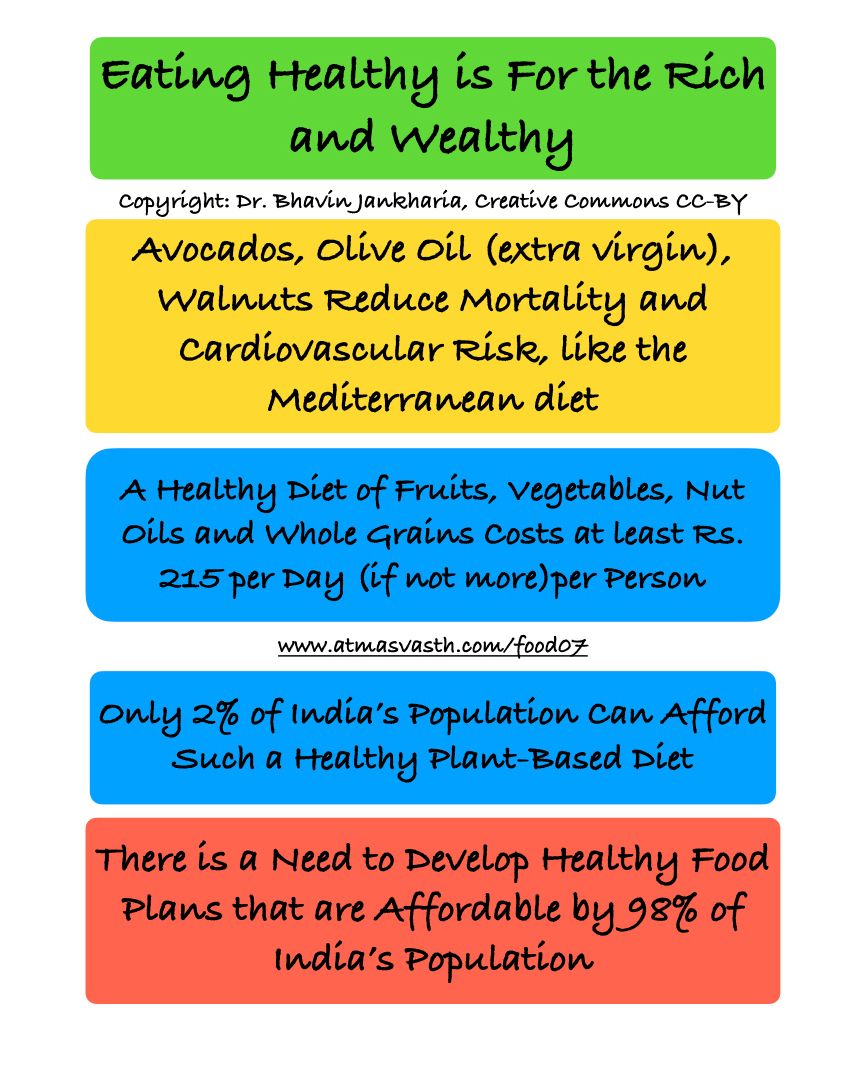Avocados, Olive Oil and Walnuts - Eating Healthy is for the Rich and Wealthy
Much of the healthy food research is focussed on expensive food items that are unaffordable by the vast majority of Indians

A recent study headed by Lorena Pacheco, published in the Journal of the American Heart Association (JAHA) [1] shows that eating just one serving of avocados per day on an average reduces the risk of cardiovascular disease and coronary heart disease (CHD) as compared to those who don’t eat avocados. One serving is a quarter of an avocado, which, for a family of four is one avocado a day, or around Rs. 250 per day for the entire family. The health benefits of avocados are postulated to be due to the presence of monounsaturated fats (MUFA) and polyunsaturated fats (PUFA) that are healthier than the saturated fats found in butter, ghee, egg, yoghurt, cheese and processed meats. They however found no difference when avocados were compared to olive oil and nuts.
Whether the advantage that comes from eating avocados regularly is real or is just due to the concept of isocaloric replacement that I mentioned in the article about peanuts and stroke (just replacing bad calories with good, irrespective of what that good calorie is) is not clear, but the isocaloric replacement theory would explain why there is no difference when avocados are compared to olive oil and nuts (all three are good replacement calories, so it would be tough to find one better than the other).
Another recent study headed by Marta Guasch-Ferre published in the Journal of the American College of Cardiology (JACC) [2] shows that those with a high consumption of olive oil have a lower risk of all-cause and cardiovascular mortality compared to those who do not consume olive oil. If olive oil replaces butter and dairy fat, the replacement also leads to reduced mortality risk, though not when olive oil is substituted by other vegetables oils (canola, safflower, corn, soybean). Though olive oil is also high in MUFAs, the possibility of isocaloric replacement remains strong.
All of these studies have been prompted by earlier studies that have shown that a Mediterranean diet (fruits, vegetables, legumes, fish, seafood and white meat) supplemented by olive oil and nuts leads to reduced mortality as compared to other diets [3]. This is why adaptations of the Mediterranean diet are now recommended worldwide.
The EAT-Lancet commission on healthy diets published a recommendation on healthy eating for individuals, societies and the planet to reduce the burden of disease and to increase sustainable practices. Published in January 2019, [4], it is a landmark study that describes how reducing red meat and increasing the intake of plant based proteins, fruits and vegetables and cutting back on carbohydrates, especially sugar based products can improve population health and reduce disease burden. It also mentions a reference diet of 2503 calories per day for a 70 kg, 30 years old individual that includes rice/wheat (whole grains), fruits, vegetables, protein sources and fats, predominantly plant-based.
We have already seen how fruits and vegetables and nuts improve health, but what we have not really looked at is the cost of such a healthy diet. The reference EAT-Lancet diet costs around 2.84 USD per person per day [5], which comes to Rs. 215 per person per day or Rs. 860 for a family for 4, which is Rs. 6450 per person per month or Rs 77,400 per year for an individual or Rs. 3.09 lakhs per year for a family of four.
Ideally, the cost of food should be around 10-15% of one’s income. In India, the “healthy” EAT-Lancet diet would constitute more than 50% of a person’s monthly income of Rs. 11,254 as of FY 2020, assuming that all members of the household earn an equal salary. Incidentally a person who earns an income of 11,254 per month is in the top 10% income earners in the country.
If you assume that not more than 20% of your earnings should go towards food, then for a Rs. 6450 per month expenditure on food, you should be earning around Rs. 32250, which is what around 1.07% of India’s population earned in 2011 (1.3 crores or 12.8 million), when its population was 1.2 billion. At today’s population of 1.4 billion, even if the number of people earning this amount has increased, the percentage is likely to be the same (1.5 crores or 15 million).
If you add the cost of avocados (Rs. 250/day), walnuts (Rs. 70) and olive oil (Rs. 40 for 1 tablespoon of extra virgin olive oil) into the mix, even if the olive oil is just for drizzling and not for cooking, less than 2% of India’s population would be able to afford healthy fruits, nuts and oils. Two percent is 28 million or 2.8 crores people (Mumbai and Ahmedabad combined) who can afford a Western “healthy” diet. No wonder superfoods are truly super-rubbish for 98% of India’s population.

If you are reading this piece, you are likely in this 2% earning bracket of Indians in India and can probably afford avocados, olive oil and walnuts on a daily basis. If you can, then go ahead and drizzle a tablespoon of olive oil every day on your salads (I do it over one serving of boiled mung), have a handful of nuts including walnuts (I try to eat mixed, unsalted, non-packaged nuts every day). I am however not sure whether non-local fruits like avocados are worth incorporating into our regular diets in our country…apples and mangoes in mango season and other local fruits are equally good.
The rest of the country needs to figure out less expensive ways of eating healthy food, where the cost comes to less than 20% of their income and still allows people to reap the same health benefits as the top 1-2% (the rich live longer...period).
The same hegemony of the rich that led to the EAT-Lancet study also dictates how research is done worldwide and why humble and inexpensive foods like chickpeas (chana), for example, are not studied with randomized controlled trials for their health benefits. This is compounded by the fact that Indians in India are really bad at doing original good research. You also wonder whether the researchers in rich Western worlds are a bit like Marie Antoinette when they study these expensive food items and assume their results could be implemented worldwide.
We need to eat healthy, which means adopting a predominantly plant-based diet consisting largely of fruits and vegetables, whole grains and nut oils or olive oil. But food has to be affordable and if our country as a whole has to eat healthy, then apart from spending money on large big hospitals and cancer centres and national grids and Ayushman Bharat, perhaps some more money and thought need to go into how to provide healthier food to people across all income levels and social classes. A healthier lifestyle focussed on prevention can impact millions of lives, unlike the much smaller impact of healthcare systems focussed on treating diseases.
Until then, as with so many other things, the rich 2% Indians will eat healthy, while the rest…
Footnotes
1. Pacheco LS, et al. J Am Heart Assoc. 2022 Apr 5;11(7):e024014
2. Guasch-Ferré M et al. J Am Coll Cardiol. 2020 Apr 21;75(15):1729-1739.
3. Estruch R et al. N Engl J Med. 2018 Jun 21;378(25):e34.
4. Willett W, al. The Lancet. 2019 Feb;393(10170):447–92.
5. Hirvonen K et al. The Lancet Global Health. 2020 Jan;8(1):e59–66.
Atmasvasth Newsletter
Join the newsletter to receive the latest updates in your inbox.


